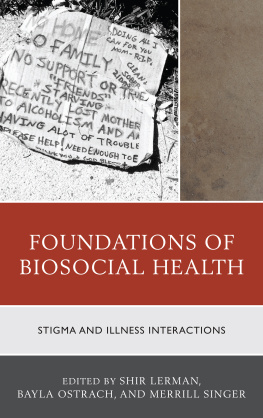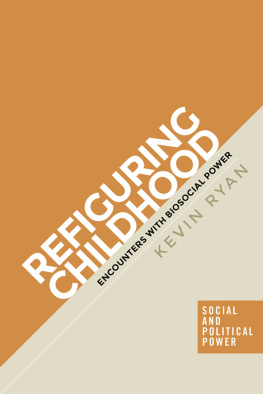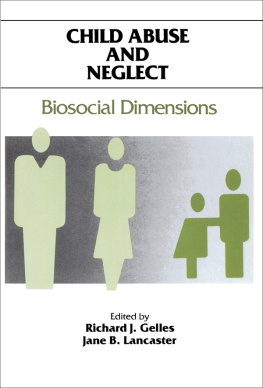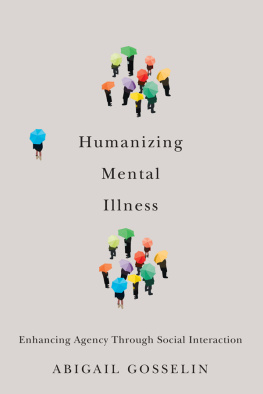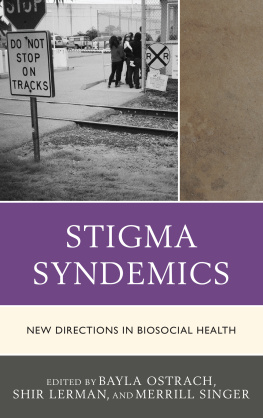Lerman Shir - Foundations of biosocial health : stigma and illness interactions
Here you can read online Lerman Shir - Foundations of biosocial health : stigma and illness interactions full text of the book (entire story) in english for free. Download pdf and epub, get meaning, cover and reviews about this ebook. year: 2018, publisher: Lexington Books, genre: Politics. Description of the work, (preface) as well as reviews are available. Best literature library LitArk.com created for fans of good reading and offers a wide selection of genres:
Romance novel
Science fiction
Adventure
Detective
Science
History
Home and family
Prose
Art
Politics
Computer
Non-fiction
Religion
Business
Children
Humor
Choose a favorite category and find really read worthwhile books. Enjoy immersion in the world of imagination, feel the emotions of the characters or learn something new for yourself, make an fascinating discovery.
- Book:Foundations of biosocial health : stigma and illness interactions
- Author:
- Publisher:Lexington Books
- Genre:
- Year:2018
- Rating:4 / 5
- Favourites:Add to favourites
- Your mark:
- 80
- 1
- 2
- 3
- 4
- 5
Foundations of biosocial health : stigma and illness interactions: summary, description and annotation
We offer to read an annotation, description, summary or preface (depends on what the author of the book "Foundations of biosocial health : stigma and illness interactions" wrote himself). If you haven't found the necessary information about the book — write in the comments, we will try to find it.
Lerman Shir: author's other books
Who wrote Foundations of biosocial health : stigma and illness interactions? Find out the surname, the name of the author of the book and a list of all author's works by series.
Foundations of biosocial health : stigma and illness interactions — read online for free the complete book (whole text) full work
Below is the text of the book, divided by pages. System saving the place of the last page read, allows you to conveniently read the book "Foundations of biosocial health : stigma and illness interactions" online for free, without having to search again every time where you left off. Put a bookmark, and you can go to the page where you finished reading at any time.
Font size:
Interval:
Bookmark:
Foundations of Biosocial Health
Foundations of Biosocial Health
Stigma and Illness Interactions
Edited by Shir Lerman, Bayla Ostrach, and Merrill Singer
LEXINGTON BOOKS
Lanham Boulder New York London
Published by Lexington Books
An imprint of The Rowman & Littlefield Publishing Group, Inc.
4501 Forbes Boulevard, Suite 200, Lanham, Maryland 20706
www.rowman.com
Unit A, Whitacre Mews, 26-34 Stannary Street, London SE11 4AB
Copyright 2017 by Lexington Books
All rights reserved . No part of this book may be reproduced in any form or by any electronic or mechanical means, including information storage and retrieval systems, without written permission from the publisher, except by a reviewer who may quote passages in a review.
British Library Cataloguing in Publication Information Available
Library of Congress Cataloging-in-Publication Data
Names: Lerman, Shir, editor. | Ostrach, Bayla, editor. | Singer, Merrill, editor.
Title: Foundations of biosocial health : stigma and illness interactions / edited by Shir Lerman, Bayla Ostrach, and Merrill Singer.
Description: Lanham : Lexington Books, [2017] | Includes bibliographical references and index.
Identifiers: LCCN 2017011602 (print) | LCCN 2017013824 (ebook) | ISBN 9781498552127 (Electronic) | ISBN 9781498552110 (cloth : alk. paper)
Subjects: LCSH: Public healthSocial aspects. | DiseasesSocial aspects. | Social medicine. | Stigmatization.
Classification: LCC RA418 (ebook) | LCC RA418 .F653 2017 (print) | DDC 362.1dc23
LC record available at https://lccn.loc.gov/2017011602
 The paper used in this publication meets the minimum requirements of American National Standard for Information SciencesPermanence of Paper for Printed Library Materials, ANSI/NISO Z39.48-1992.
The paper used in this publication meets the minimum requirements of American National Standard for Information SciencesPermanence of Paper for Printed Library Materials, ANSI/NISO Z39.48-1992.
Printed in the United States of America
Introduction
Merrill Singer, Shir Lerman, and Bayla Ostrach
In this book, the authors conceive of health as a product of the enduring interaction of diverse biological and social factors. As skillfully demonstrated by the contributors to this volume, health is socially contextualized and produced, and, in turn, has dramatic impacts on society. Stigma, as a social factor, has particular effects on the biological and structural dimensions of health and as such drives many deleterious health interactions.
Consider the example of Human Immunodeficiency Virus (HIV) disease, a recurring theme in this edited volume. While indisputably a biological condition working at the cellular level through gradual viral destruction of the immune system, HIV became a global pandemic because of social factors (e.g., globalization); it is disproportionately an affliction of the poor and other socially marginalized groups because of the immediate effects of social hierarchy on risk exposure and on risky behavior (Brennan et al. 2012; Jha and Madison 2009; Logie et al. 2012). Except for heuristic purposessuch as focused biological assessment of CD4 (white cell) penetration, reorganization, and cell deathit is not possible to fully understand HIV disease in population health separate from its social contexts, determinants, and consequences. Of special concern in these two volumes is the role of social stigma in this and other mutually exacerbating health interactions.
As a health and social science concept, stigma has a fifty-year history that first gained attention with Erving Goffmans seminal work (1963). Its roles in disease processes, human social suffering, life chances, and social control have been addressed in a broad, multidisciplinary literature (Goffman 1963; Hopper 1981; Kleinman and Hall-Clifford 2009; Jenkins and Carpenter-Song 2008; Puhl and Heuer 2010). Central to the understanding of stigma is the assertion of consequential social difference. In its original connotation in ancient Greek society, stigma referred to brand marks burned into the flesh of slaves to demarcate ownership. Frederick Douglas described precisely the same practice among slave owners in the antebellum South as a means of: imprinting upon [flesh] the name of the monster who claimed the slave (quoted in Hoenig 2012:271). Through this act, an individual was both marked as different and as having a significantly inferior social standingthat is, as being an inherently different kind of being than the slave ownerand inflicted by the process of branding and its social implications to profound misery and social disgrace. As Erving Goffman (1963:12) commented in his groundbreaking book Stigma: Notes on the Management of Spoiled Identity , Today the term is widely used in something of the original sense, but is applied more to the disgrace itself than to the bodily evidence of it.
In short, as used in contemporary analysis, physical marks of ignominy (e.g., the skin lesions of karposi sarcoma that came to be a stigmatizing condition among individuals with dual infection of herpesvirus and HIV), are not required to subject a socially linked set of individuals to damaging opprobrium (e.g., as seen in abortion stigma, a topic explored in the second book in this set, Stigma Syndemics: New Directions in BioSocial Health ). Stigma does not merely develop due to pre-existing differences among human groups (e.g., hair color) or segments of society, most of which are not elevated to the level of determinant social status, but rather commonly feeds upon, strengthens and reproduces existing inequalities of class, race, gender and sexuality among other distinctions (Parker and Aggleton 2003:13).
Link and Phelan (2006) assessed stigma as involving a set of five components: 1) identification and labelling of socially charged human differences; 2) stereotypic association of certain differences as undesirable or even threatening; 3) some form of social separation of the stigmatized from others in society through discrimination or other mechanisms; 4) harmful loss of social status among those in a stigmatized social grouping; and 5) the exercise of power and social control with corresponding loss of rights, access, and privacy.
Stigma, including the expectation of prejudice and discrimination and the internalization of stigma (i.e., accepting as true negative stereotypes about ones group), has significant health implications (Lewis et al. 2006). Stress is a key biological mechanism in stigmatization, an intermediate variable, and process, linking stigma to the production of disease (Rsch et al. 2013). Stress includes two observable types: acute stress, produced by sudden and usually unexpected events that disrupt everyday social life and relationships (e.g., divorce), and chronic social stress, referring to enduring and often emotionally damaging problems (e.g., poverty) that threaten an individuals personal and social identity, and in turn, his/her health.
While the healthy body can readily handle acute stress, chronic stress, like that caused by stigma, does not allow the body to achieve or return to homeostasis. Rather, body parameters (e.g., blood pressure, blood glucose, immune system functioning), change and do not drop to pre-stress levels but may be re-set at a more harmful level. This change is referred to as allostasis and the build-up of such changes is called allostatic load. Over time, the increase of allostatic load in the body can lead to disease onset (Dressler 2007; McEwan 2000). Stigma stress also can promote various coping behaviors that are, in turn, notably risky and lead to additional harm (e.g., smoking, illicit drug use, unprotected sex) (Lick et al. 2013). Moreover, stigma discrimination can push people to inhabit unsafe places (ecologically degraded, toxic, and polluted environments) or deny them access to resources (food, health care) that also are sources of disease promotion. The end result is the potential for a clustering of diseases in a stigmatized population as seen in the chapters in this volume. Increasingly, the study of epigenetics also draws attention to the intergenerational health threats of chronic stress (Gudsnuk and Champagne 2012; Stankiewicz et al. 2013), revealing the long-term toll of this product of social inequality.
Next pageFont size:
Interval:
Bookmark:
Similar books «Foundations of biosocial health : stigma and illness interactions»
Look at similar books to Foundations of biosocial health : stigma and illness interactions. We have selected literature similar in name and meaning in the hope of providing readers with more options to find new, interesting, not yet read works.
Discussion, reviews of the book Foundations of biosocial health : stigma and illness interactions and just readers' own opinions. Leave your comments, write what you think about the work, its meaning or the main characters. Specify what exactly you liked and what you didn't like, and why you think so.

